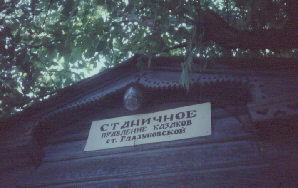| The earliest Cossack communities
came into being during the 16th century on the rivers Dnepr, Don, Jaik (Ural
since 1775) and Terek. They secured their existence through hunting, fishing,
plundering and small military actions against the Turks and Tatars, living
in fortified camps which later gave rise to the typical Cossack villages
(stanitsy). Beginning in the 17th century, the Cossacks also became active
in agriculture and pastoralism. The egalitarian principle and the autonomy
of Cossack adminstration placed a great deal of emphasis on the indepedance
of the Cossacks from the centralized state. Governed by a ring-constitution
(krug), whose full assembly or assembly of representative elected the leader
(ataman), this form of administration showed some amount of democratic characteristics.
However, in the final analysis, this way of ruling still represented a strictly
patriarchal order which excluded women and men under 25 years of age. The
majority of the Cossacks was forced to abide by the will of the Cossack
elite (starshina). The autonomous Cossack government functioned as a state
with a state. For this reason, the Cossacks always played a significant
role in the most important uprisings in Russian history. Due to the pressures
of serfdom, indentured labor, taxation, brutal recruitings and the persecution
of religious minority (the Cossacks always saw themselves as defender of
Russian Othodoxy but especially favored the Old Believers), more and more
people sought protection from the Cossack community. These malcontents could
easily be mobilized to revolt: :
- the anti-Polish uprising
under the Hetman Bogdn Chmelnitski of 1648
- the revolt of Stenka Rasin
of 1670
- the uprising under Yemelyan
Pugatchov from 1773-1775
The most famous Cossack community
is the so-called Saporog Setsh (Ukrainian: sitsh) on the lower Dnepr.
Under Catherine the Great, the Setsh was abolished; its hetman was imprisoned
in the Solovets Monastery: the hetmanship was finally done away with for
good in 1764. The severe repression of the Cossacks was followed by the
integration of Cossack units into Tsarist border troops. In areas such
as the Northern Caucasus, Astrakhan, Orenburg, and Siberia, the government
founded its "own" Cossack communities. The Cossack leaders as well as
the higher-ranking officers were now no longer elected but named by the
Tsar or the Ministry of War. Through priviledges and freedom from taxation,
a land-owning aristocracy came into being among the Cossacks. In the lower
social layers, a so-called wave of "agriculturization" had a great effect.
During the 19th century, the
Don-Cossacks still remained as an independent military grouping (sosloviye)
with a well-developed identity; in the early 20th century, they were the
most important Cossack community, comprising 17 of 35 Cossack-regiment
in the Tsarist army. As loyal supporters of the Tsar, they functioned
as pillars of the Tsarist order, supressing worker's uprisings and political
revolt.
After the October revolution, short-lived Cossack-Republics
were formed. However, these could hardly realize their claims for autonomy.
In the course of the civil war, most of the Cossacks deserted from the
White troops to the Red Army. Many other fled abroad.
The forced collectivization and the "battle against
the Kulacks" during the 1930s also affected many of the Cossacks who had
remained in the Soviet Union. Their revolts were put down bloodily. During
the Second World War, the by-now obsolete Cossack cavalry supported the
Red Army.
Since the 1990s, the Cossack
community has been experiencing a revival in connection with the renewal
of Ukrainian national consciousness.
Regina Kraus
|

